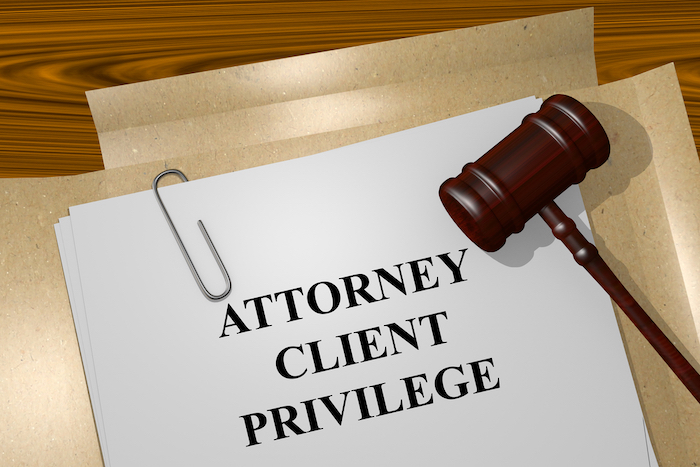“This case is a reminder for both companies and lawyers…[that] initiating litigation without an objective basis and using litigation procedures as an unfair competition tool to interfere with a competitor’s business may be considered a sham lawsuit.”
 The protection of privilege in communications between clients and lawyers is a very important one under U.S. law. The basic rule is that when a client seeks legal advice from a lawyer, the communication between the client and the lawyer is confidential and cannot be discovered during litigation. An important purpose of this rule is to encourage clients to communicate fully and freely with lawyers in the process of seeking legal help. The lawyers here include both external lawyers and in-house lawyers.
The protection of privilege in communications between clients and lawyers is a very important one under U.S. law. The basic rule is that when a client seeks legal advice from a lawyer, the communication between the client and the lawyer is confidential and cannot be discovered during litigation. An important purpose of this rule is to encourage clients to communicate fully and freely with lawyers in the process of seeking legal help. The lawyers here include both external lawyers and in-house lawyers.
However, such privilege protection is not absolute. For example, if a client seeks an attorney’s legal services for criminal or fraudulent purposes, he or she is not entitled to privilege protection. This is the “crime-fraud exception” to the attorney-client privilege. The case described below involves the “fraud” exception.
In re: Abbott Laboratories, et al.
Abbott (the petitioner in this case) is the owner of a pharmaceutical patent. Perrigo and Teva are two pharmaceutical companies that sought Food and Drug Administration (FDA) approval for two generic drugs, respectively, claiming that the petitioners’ patents were either invalid or did not cover the formulations of their generic drugs.
Abbott sued Perrigo and Teva for patent infringement on the two generic drugs during the litigation window provided by the Hatch-Waxman Act, and subsequently reached settlement agreements with both. In Perrigo ‘s case, Abbott paid $2 million to Perrigo in exchange for Perrigo delaying the launch date of its generic drugs; in Teva ‘s case, Abbott agreed to grant a patent license to Teva starting from a later date.
Later, the Federal Trade Commission (FTC) alleging that it maintained an illegal monopoly position by initiating sham patent lawsuits against two potential competitors. The U.S. District Curt for the Eastern District of Pennsylvania held in 2018 that Abbott’s corporate legal affairs department had “actual knowledge” that the lawsuit was “baseless” and acted “in bad faith”. The court said the only purpose of launching the lawsuit was to impose on the competitor costs and delay. The U.S. Court of Appeals for the Third Circuit upheld the district court’s judgment, finding that Abbott maliciously filed an objectively baseless lawsuit to injure potential competitors. The case eventually went up to the Supreme Court but AbbVie/Abbott’s petition for certiorari was denied in June 2021 and the FTC withdrew its claims and ended the litigation.
After the Third Circuit’s judgment was rendered, some other entities (the respondents) initiated a lawsuit against the petitioner, which is the present case, claiming that the petitioner violated the Sherman Act in delaying the launch of generic drugs by initiating patent infringement lawsuits, including the Perrigo case, which constitutes a monopoly.
After the evidence discovery process was initiated, the respondent requested that the court order the petitioner to provide a number of documents that could reveal the views of its legal counsel in the Perrigo case about the baselessness of the lawsuits. The Petitioner claimed that the documents under request were protected by attorney-client privilege. But the respondent alleged that, given that the court had determined that Abbott’s lawsuit was a sham, any communication from the petitioner’s attorney regarding whether to file such a lawsuit is for the purpose of fraud, thereby constituting the crime-fraud exception to attorney-client privilege.
The court ultimately ordered the petitioner to provide some requested documents, holding that it could be reasonably inferred that the petitioner’s legal counsel knew that a sham lawsuit would be filed and used the relevant documents in support of the fraud purpose, thus rendering these documents unprotected by the attorney-client privilege.
Abbott petitioned the U.S. Court of Appeals for the Third Circuit for a writ of mandamus to vacate the district court’s order. The Third Circuit held that the requirements for grant of a mandamus order were not met and rejected the petitioner’s request. (In re: Abbott Laboratories, No. 23-2412 (3d Cir. 2024)).
Takeaway
Although the district court determined that a sham lawsuit could be “fraud” within the meaning of the “crime-fraud” exception to the attorney-client privilege, as the Third Circuit noted, the court did not have a binding authority for that. In the absence of a binding legal basis, the Third Circuit held that the district court’s conclusion that a sham litigation could trigger the “crime-fraud” exception was not a “clear and undisputed abuse of discretion or error of law”.
Secondly, different circuit courts in the United States may have different standards for determining “fraud”. For example, the petitioner in this case claimed that when the U.S. Court of Appeals for the Federal Circuit examined this issue in patent cases, it concluded that if (the actor) did not make a misrepresentation of fact or (the other party) did not rely on the misrepresentation, there would be no fraud exception to the privilege protection. However, the Third Circuit considered that the Federal Circuit had no jurisdiction over this case, and the district court applied Third Circuit law and found that there was no clear error in determining there is no “reliance requirement” in the fraud exception.
Third, as the Third Circuit mentioned, sham litigation needs to be distinguished from frivolous litigation under Rule 11 of the Federal Rules of Civil Procedure. Frivolous litigation may trigger sanctions but does not necessarily constitute an exception to the attorney-client privilege. In this case, the “crime-fraud exception” was triggered because of the objectively baseless litigation launched by the petitioner, combined with its subjective intention to use its patent rights to interfere with relevant administrative and judicial procedures.
Finally, this case is a reminder for both companies and lawyers (including external lawyers and corporate legal counsel). Whether it is taking advantage of the litigation opportunity provided by the generic drug marketing approval process, as shown in this case, or at other litigation opportunities that are considered “favorable”, initiating litigation without an objective basis and using litigation procedures as an unfair competition tool to interfere with a competitor’s business may be considered a sham lawsuit. In this case, the party’s sham lawsuit not only led to its loss of the antitrust lawsuit initiated by the FTC, but also subsequently triggered the antitrust civil lawsuit initiated by the respondents in the present case. It may also risk losing the critically important attorney-client privilege protection in the litigation process.
Image Source: Deposit Photos
Author: Premium_shots
Image ID: 90815006

![[IPWatchdog Logo]](https://ipwatchdog.com/wp-content/themes/IPWatchdog%20-%202023/assets/images/temp/logo-small@2x.png)

![[Advertisement]](https://ipwatchdog.com/wp-content/uploads/2024/04/UnitedLex-May-2-2024-sidebar-700x500-1.jpg)
![[Advertisement]](https://ipwatchdog.com/wp-content/uploads/2024/04/Patent-Litigation-Masters-2024-sidebar-700x500-1.jpg)

![[Advertisement]](https://ipwatchdog.com/wp-content/uploads/2021/12/WEBINAR-336-x-280-px.png)
![[Advertisement]](https://ipwatchdog.com/wp-content/uploads/2021/12/2021-Patent-Practice-on-Demand-recorded-Feb-2021-336-x-280.jpg)
![[Advertisement]](https://ipwatchdog.com/wp-content/uploads/2021/12/Ad-4-The-Invent-Patent-System™.png)






Join the Discussion
No comments yet. Add my comment.
Add Comment